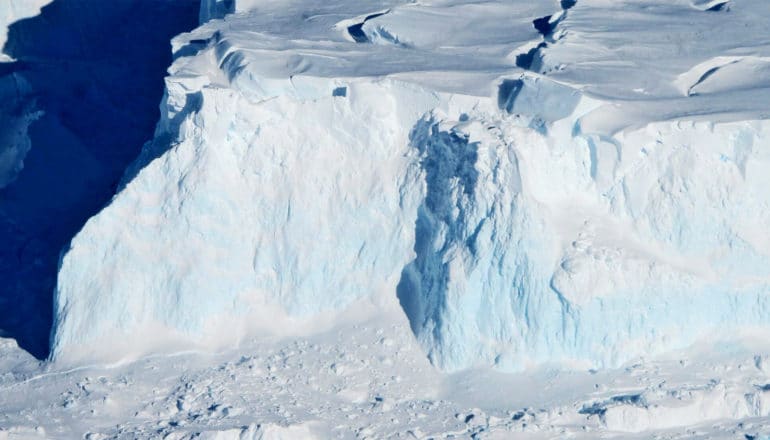
The world’s largest ice sheets may be in less danger of sudden collapse than previously predicted, according to a new study.
The study in Science includes simulating the demise of West Antarctica’s Thwaites Glacier, one of the world’s largest and most unstable glaciers.
Researchers modeled the collapse of various heights of ice cliffs—near-vertical formations that occur where glaciers and ice shelves meet the ocean. They found that instability doesn’t always lead to rapid disintegration.
“What we found is that over long timescales, ice behaves like a viscous fluid, sort of like a pancake spreading out in a frying pan,” says Jeremy Bassis, associate professor of climate and space sciences and engineering at the University of Michigan. “So the ice spreads out and thins faster than it can fail and this can stabilize collapse. But if the ice can’t thin fast enough, that’s when you have the possibility of rapid glacier collapse.”
The researchers combined the variables of ice failure and ice flow for the first time, finding that stretching and thinning of ice, as well as buttressing from trapped chunks of ice, may moderate the effects of fracture-induced marine ice cliff instability.
Iceberg calving
The new findings add nuance to a previous theory called marine ice cliff instability, which suggests that if the height of an ice cliff reaches a certain threshold, it can suddenly disintegrate under its own weight in a chain reaction of ice fractures.
The Thwaites Glacier in Antarctica—sometimes referred to as the “Doomsday Glacier”—is moving closer to this threshold and could contribute nearly 3 feet to sea level rise in the event of a complete collapse. At 74,000 square miles, it’s roughly the size of Florida, and is particularly susceptible to climate and ocean changes.
“The ocean is always there, sort of tickling the ice in a very complex way, and we’ve only known for a decade or two just how important it is.”
Researchers also found that icebergs that crack and fall away from the main glacier in a process known as “iceberg calving” may actually stave off, rather than contribute to, catastrophic collapse. If the ice chunks get stuck on outcroppings in the ocean floor, they can exert back pressure on the glacier to help stabilize it.
Bassis notes that even if the glacier doesn’t catastrophically collapse, exposing a tall cliff could still trigger a retreat at a few kilometers per year—equal to the length of about 20 football fields—resulting in a large contribution to future sea level rise.
Complete collapse of Thwaites Glacier?
While it’s clear that Thwaites and other glaciers are melting, the speed of their demise is of keen interest to coastal areas as they develop strategies to adapt and build resilience.
But predicting the retreat of glaciers is a mind-bendingly complex business, as they’re affected by the interplay of myriad factors—the stress and strain of billions of tons of shifting ice, changing air and water temperatures, and the effects of flowing liquid water on ice, to name just a few.
As a result, the predictions for the collapse of the Thwaites Glacier range from a few decades to many centuries. The new study, Bassis says, is an important step toward producing accurate, actionable predictions.
“There’s no doubt that sea levels are rising, and that it’s going to continue in the coming decades,” Bassis says. “But I think this study offers hope that we’re not approaching a complete collapse—that there are measures that can mitigate and stabilize things. And we still have the opportunity to change things by making decisions about things like energy emissions—methane and CO2.”
Fate of Antarctic and Greenland ice sheets
The study’s findings will also be useful for predicting the fate of other glaciers and ice formations in the Arctic and Antarctica, says Anna Crawford from the University of St. Andrews.
“These important insights will inform future research into the retreat of Thwaites Glacier and other large outlet glaciers of the West Antarctic ice sheet that are vulnerable to retreat via ice cliff failure and marine ice cliff instability,” she says. “They highlight the conditions that facilitate retreat, demonstrate the potential for terminus restabilization and show how sea ice can actually put the brakes on the collapse process.”
The research team is already working to refine their models further by incorporating additional variables that affect glacial retreat, including how the shapes of individual glaciers affect their stability and the interaction between glacial ice and the liquid ocean around it, Bassis says.
“The ocean is always there, sort of tickling the ice in a very complex way, and we’ve only known for a decade or two just how important it is,” he says. “But we’re beginning to understand that it’s driving a lot of the changes we’re seeing, and I think that’s going to be the next big frontier in our research.”
Additional researchers from the University of Michigan and the University of St. Andrews contributed to the work.
The study is part of the International Thwaites Glacier Collaboration. The DOMINOS project, a component of the International Thwaites Glacier Collaboration, the National Science Foundation, and the Natural Environment Research Council funded the work.
Source: University of Michigan
The post ‘Doomsday Glacier’ may be more stable than feared appeared first on Futurity.
from Futurity https://ift.tt/3wRojUU
No comments:
Post a Comment